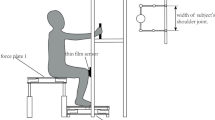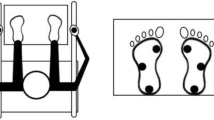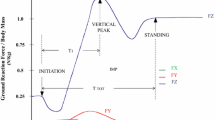Abstract
Purpose
Sit-to-stand (STS) is a basic skill for maintaining a high-quality life. The purpose of this study was to examine the effect of handrail height on the peak moment of the lower extremity joint under the support of the knee joint in ST and to provide quantified kinematics and kinetics data to help determine the STS movement strategy under the optimal handrail height. This research could also provide a starting point for the design and control of STS assistive devices.
Methods
Thirty healthy young adult subjects participated in this experiment. They grabbed handrails of different heights to perform STS at a speed of their choice. Kinematics data from the marker points at the subject’s joints were obtained through a high-definition camera, and the reaction forces at the foot, hip, and knee were measured through force-measuring devices. The inverse kinetics method was used to calculate the moment of the subject’s lower limb joints. Finally, kinematics data and kinetic data were analyzed and compared.
Results and conclusions
The peak moments of the knee joint and hip joint at different handrail heights were significantly different (P = 0.005, P < 0.001). As the handrail height increased, the peak moments of the knee joint and hip joint decreased and the maximum trunk tilt angle also decreased significantly (P < 0.001). These findings indicated that the use of a combination of knee joint support and high handrails could make STS movement easier.






Similar content being viewed by others
Data availability
The datasets used and/or analyzed for the current study are available from the corresponding author on reasonable request.
Code availability
Not applicable.
References
Alexander NB, Schultz AB, Warwick DN. Rising From a Chair: Effects of Age and Functional Ability on Performance Biomechanics. J Gerontol. 1991;3:91–8.
Bohannon RW, Barreca SR, Shove ME, Lambert C, Masters LM, Sigouin CS. Documentation of daily sit-to-stands performed by community-dwelling adults. Physiother Theory Pract. 2008;24(6):437–42.
Burnfield J M, Bernadette M C, Yu S, et al. Comparative Kinematic and Electromyographic Assessment of Clinician- and Device-Assisted Sit-to-Stand Transfers in Patients With Stroke[J]. Physical Therapy (10):1331–41.
Chihara T, Fukuchi N, Seo A. Optimum position and orientation of handrail for sit-to-stand movement. Journal of Advanced Mechanical Design Systems and Manufacturing. 2015;9(3):JAMDSM0036–JAMDSM0036.
Chou SW, Wong AMK, Leong CP, Hong WS, Tang FT, Lin TH. Postural control during sit-to stand and gait in stroke patients. Am J Phys Med Rehabil. 2003;82(1):42–7.
Dekker D, Buzink SN, Molenbroek JMF, Bruin RD. Hand supports to assist toilet use among the elderly. Appl Ergon. 2007;38(1):109–18.
Gordon D, Robertson E, Caldwell GE. Research Methods in Biomechanics, Research Methods in Biomechanics, Place Published, 2013.
Hirata Y, Higuchi J, Hatsukari T, Kosuge K. Sit-to-stand assist system by using handrail and electric bed moving up and down. IEEE Ras & Embs International Conference on Biomedical Robotics & Biomechatronics. 2008.
Janssen WGM, Bussmann Hans BJ, Stam HJ. Determinants of the Sit-to-Stand Movement: A Review. Phys Ther. 2002;9:9.
Janssen WGM. The Sit-to-Stand Movement recovery after stroke and objective assessment. erasmus mc university medical center rotterdam. 2008.
Kato T, Sekiguchi Y, Honda K, Izumi S, Kanetaka H. Comparison of handrail reaction forces between two different handrails during sit-to-stand movement in the elderly - ScienceDirect. Clinical Biomechanics, 2020, 80.
Kim S W, Song J, Suh S, et al. Design And Experiment Of A Passive Sit-To-Stand And Walking (STSW) Assistance Device For The Elderly[C]// 2018 40th Annual International Conference of the IEEE Engineering in Medicine and Biology Society (EMBC). IEEE, 2018.
Kinoshita S. Handrail position and shape that best facilitate sit-to-stand movement. J Back Musculoskelet Rehabil. 2012;25(1):33–45.
Kinoshita S, Kiyama R, Yoshimoto Y. Manabu. Effect of Handrail Height on Sit-To-Stand Movement. Plos One. 2015, 10(7): e0133747.
Kralj A, Jaeger RJ, Munih M. Analysis of standing up and sitting down in humans: definitions and normative data presentation. J J Biomech. 1990;23(11):1123–38.
Lee SJ, Mehta-Desai R, Oh K, Sanford J, Prilutsky BI. Effects of bilateral swing-away grab bars on the biomechanics of stand-to-sit and sit-to-stand toilet transfers. Disabil Rehabil Assist Technol. 2018;14(3):1.
Lindemann U, Claus H, Stuber M, et al. Measuring power during the sit-to-stand transfer[J]. Eur J Appl Physiol. 2003;89(5):466–70.
Linden DWV, Brunt D, Mcculloch MU. Variant and invariant characteristics of the sit-to-stand task in healthy elderly adults. Arch Phys Med Rehabil. 1994;75(6):653–60.
Maki BE, Sibley KM, Jaglal SB, Bayley M, Brooks D, et al. Reducing fall risk by improving balance control: Development, evaluation and knowledge-translation of new approaches[J]. J Safety Res. 2011;42(6):473–85.
Mapaisansin P, Suriyaamarit D, Boonyong S. The development of sit-to-stand in typically develo** children aged 4 to12 years: Movement time, trunk and lower extremity joint angles, and joint moments. 2020 (76) 14–21.
Matjacic Z, Zadravec M, Oblak J. Sit-to-Stand Trainer: An Apparatus for Training "Normal-Like" Sit to Stand Movement[J]. IEEE Transactions on Neural Systems & Rehabilitation Engineering A Publication of the IEEE Engineering in Medicine & Biology Society, 2015, 24(6).
Naomi K, Fukagawa, Albert, B, Schultz. Muscle Function and Mobility Biomechanics in the Elderly: An Overview of Some Recent Research. J Gerontol A Biol Sci Med Sci. 1995, 50A(Special Issue):60–63.
Norman-Gerum V, Mcphee J. Comprehensive description of sit-to-stand motions using force and angle data[J]. J Biomech. 2020;112:110046.
Nuzik S, Lamb R, Vansant A, Hirt S. Sit-to-Stand Movement Pattern A Kinematic Study. Phys Ther. 1986;66(11):1708.
Pinheiro C, Lopes J M, Moreira L, Sanz-Merodio D, Garcia E. Kinematic and kinetic study of sit-to-stand and stand-to-sit movements towards a human-like skeletal model. 2019 IEEE 6th Portuguese Meeting on Bioengineering (ENBENG). IEEE, 2019.
Protection B, Labour MO. Human dimensions of Chinese adults. 1988.
Qiu C, Okamoto S, Yamada N, Akiyama Y, Yamada Y. Patient Simulation: Handrail Position for Knee-OA Patients Considering Physical Burden and Stability. 2019 IEEE 1st Global Conference on Life Sciences and Technologies (LifeTech). 2019.
Qiu C, Okamoto S, Akiyama Y, Yamada Y. Lower-limb moments during sit-to-stand movement with different handrail grip position and trunk tilt angle. 2020 IEEE/SICE International Symposium on System Integration (SII). IEEE, 2020.
Roebroeck ME, Doorenbosch CAM, Harlaar J, Jacobs R, Lankhorst GJ. Biomechanics and muscular activity during sit-to-stand transfer. Clin Biomech. 1994;9(4):235.
Sekiguchi Y, Honda K, Phakdepiboon T, **de M, Kato T, Kanetaka H, Izumi S. Effects of shelf bar assistance on kinetic control during sit-to-stand in healthy young and elderly subjects. ScienceDirect. Journal of Biomechanics, 2020, 106.
Takeda K, Katsuhira J, Takano A. Effects of handrail use during sit-to-stand in the third trimester. Int J Ind Ergon. 2009;39(6):988–94.
Turcot K, Armand S, Fritschy D, Hoffmeyer P, Suvà D. Sit-to-stand alterations in advanced knee osteoarthritis. Gait & Posture. 2012;36 1:68–72.
Yamakawa K, Okamoto S, Kubo R, Yamada N, Akiyama Y, Yamada Y. Knee Pain Patient Simulation for Recommendation of Sit-to-Stand Handrail Positions.IEEE Transactions on Human-Machine Systems, 2019, PP (99):1–7.
Yoshioka S, Nagano A, Himeno R, Fukashiro S. Computation of the kinematics and the minimum peak joint moments of sit-to-stand movements. Biomed Eng Online. 2007;6(1):26–26.
Yoshioka S, Nagano A, Hay D C, Fukashiro S. Peak hip and knee joint moments during a sit-to-stand movement are invariant to the change of seat height within the range of low to normal seat height. BioMedical Engineering OnLine,13,1(2014–03–12), 2014, 13(1):27.
Acknowledgements
The authors thank The Tian** Natural Science Foundation (19JCZDJC33200), Tian** Natural Science Foundation (18JCQNJC75300).
Funding
This study has been funded by The Tian** Natural Science Foundation (19JCZDJC33200), Tian** Natural Science Foundation (18JCQNJC75300).
Author information
Authors and Affiliations
Contributions
Conceptualization: Min Li, Qiang Xue, Shuo Yang, **aolong Han, Shouwei Zhang.
Formal analysis: Min Li
Methodology: Min Li, Qiang Xue
Supervision: Qiang Xue
Visualization: **aolong Han, Shouwei Zhang
Corresponding author
Ethics declarations
Ethics approval
This study was approved by the Academic Ethics and Scientific Ethics Committee of the Academic Committee of Tian** University of Science and Technology.
Consent to participate
All subjects provided informed consent prior to participation.
Consent for publication
Not applicable.
Competing interests
The authors declare no competing interests.
Additional information
Publisher's note
Springer Nature remains neutral with regard to jurisdictional claims in published maps and institutional affiliations.
Rights and permissions
About this article
Cite this article
Li, M., Xue, Q., Yang, S. et al. Effects analysis of handrail height on sit-to-stand movement under knee joint support in healthy young adults. Res. Biomed. Eng. 38, 617–628 (2022). https://doi.org/10.1007/s42600-022-00212-4
Received:
Accepted:
Published:
Issue Date:
DOI: https://doi.org/10.1007/s42600-022-00212-4




